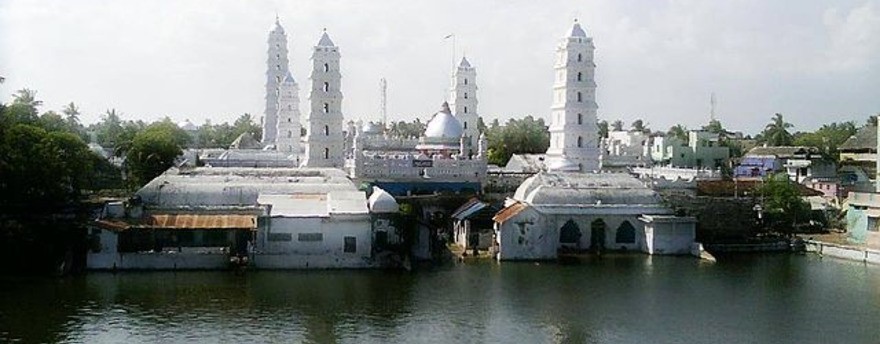Nagore Dargah

Located in the coastal town Nagore in Nagapattinam district is the Dargah built over the tomb of Sufi saint Shahul Hameed. Nagore Dargah is known by different names – Nagoor Dargah, Syed Shahul Hameed Dargah or Nagore Andavar Dargah.
There are three Nagore shrines that are situated at Nagore, Vanjur and Silladi, Nagore being the prime shrine.
Image Attribution : Sundaramrajaraman
About Saint Syed Shahul Hameed
Nagore Miran, the 16th century Muslim Sufi saint was born as Shahul Hameed in Manikhpur in North India. He took to spiritualism early in his life and travelled through West Asia to Mecca, to Burma and on to China before he reached Ceylon and the South Indian coast.
Saint Shahul Hameed was venerated locally as Nagore Andavar (meaning the ‘God of Nagore’). He is believed to have performed many miracles in Nagore and cured a 16th century Hindu ruler of Thanjavur, King Achutappa Nayak, of his physical ailment due to sorcery or black magic. Local lore has it that Shahul Hameed believed that a needled pigeon in the palace was the cause of the king’s misery and so removed the pins from the pigeon. This resulted in the king’s improvement in health conditions. In remembrance of this event, the custom of setting pigeons free is still continued in the dargah.
The mysticism of the saint touched the lives of people across faiths, from the rulers to commoners.
History of Nagore Dargah
Once King Achutappa Nayak was cured of his affliction, he donated 200 acres of land to the followers of the Saint. The Dargah was built on a part of the land so donated.
Shahul Hameed is believed to have predicted his death and advised his adopted son Yusuf about his burial location. A mausoleum was built over his grave. The Dargah was built by ardent devotees of Shahul Hameed, with a major contributions from Hindus.
Architecture
Nagore Dargah covers an area of 5 acres enclosed by a compound wall. The main complex has four entrances, one in each direction. The Dargah has five minarets in different heights. The tallest one has a height of 131 ft. The other four minarets are Sahib Minara (77 ft), Thalaimattu Minara (93.5 ft), Muthubaq Minara (93.25 ft) and Ottu Minara (80 ft). The central part of the tomb houses the tomb of Saint Shahul Hameed. The tomb can be approached through seven thresholds, three of which are made of gold and the remaining four of silver. The dargah houses the tombs of Shahul, his son Yusuf and his daughter-in-law Saeeda Sultana Biwi.
Nagore Dargah Timings & Festivals
The outer doors of the dargah are always kept open, while the inner doors are open from 4:30 AM to 7:00 AM and from 6:25 PM to 9:30 PM. The inner doors are open additionally from 12 Noon to 2:30 PM on Fridays alone.
‘Kanduri Urs’ festival is celebrated in commemoration of the anniversary of the saint’s death. It is a 14-day event observed once in a year that includes saffron flag-carrying ceremony, procession in streets, recitation of Quaranic verses and observance of Fatiha.
How to reach Nagore Dargah
There are regular buses to Nagore from Nagapattinam (4 kilometres away), Karaikkal (12 kilometres away), Thanjavur (78 kilometres away) and Chennai (90 kilometres away). The nearest railway station is at Nagapattinam. The nearest airport is at Trichy, around 150 kilometres from Nagore.
Epilogue
Nagore Dargah marks a prominent and common place of worship for devotees of varying religions who flock to the dargah where the Sufi mystic lies buried. It is believed by Hindu fishermen that Nagore Andavan rescues them whenever there is turbulence in the sea and their life is at risk. It’s a noteworthy fact that fishermen living around 300 kilometres north of Nagore still name their boats after their patron saint of the seas. Considered as the ‘Ajmer of South India’, the shrine of Nagore attracts many devotees from different religions and communities, throughout the year.
